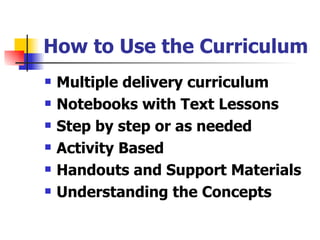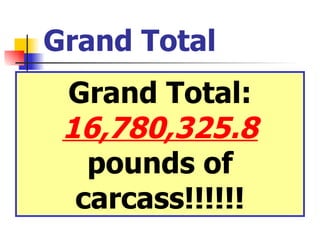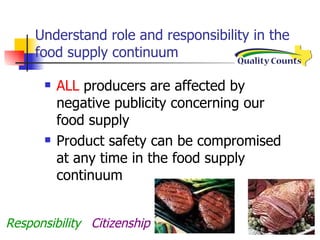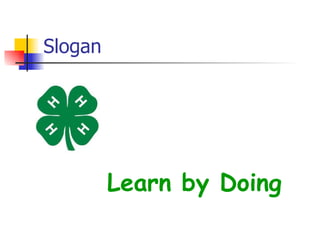Galaxy(2)
- 1. A Texas Curriculum for Livestock Education Sheep and Goat MENTOR Training
- 2. Curriculum Focus Quality Assurance Character Education
- 3. Objective 1 Ensure all 4-H and FFA livestock projects meet all food quality standards
- 4. Objective 2 Enhance character education for Texas 4-H and FFA Youth
- 5. Objective 3 Promote a Positive Image of Youth Livestock Programs
- 6. How to Use the Curriculum Multiple delivery curriculum Notebooks with Text Lessons Step by step or as needed Activity Based Handouts and Support Materials Understanding the Concepts
- 7. Eight Core Concepts Objective 1: Quality Assurance Impact of Livestock Projects on Red Meat Industry Responsibilities of Producing a Safe Product Medication use/Reading and Following Labels Animal Care and Well-Being Objective 2: Character Education Six Pillars of Character Purpose of 4-H/FFA Purpose of Livestock Projects Making Decisions/Goal Setting
- 8. Core Concept Objective 1: Quality Assurance Core Concept 1: Impact of Livestock Projects on Red Meat Industry
- 9. Reveal impact of 71,000 market projects
- 10. Total Entry Numbers Market Swine: 34,126 Meat Goats: 17,651 Market Lamb: 11,837 Market Steers: 7,582 TOTAL: 71,196
- 11. How many pounds of carcass are there? Terms & Calculations : (1) Live Weight, (2) Dressing Percent, and (3) Carcass Weight
- 12. SHEEP Ave Wt. – 125 D. P. - 53% 784,793.1 lb
- 13. Grand Total Grand Total: 16,780,325.8 pounds of carcass!!!!!!
- 14. What does this mean? Livestock projects can IMPACT thousands of people!!! Think about the CONSUMER!!!! You never know who they might be……..
- 15. Core Concept Objective 1: Quality Assurance Core Concept 2: Responsibility of Producing a Safe Product
- 16. Lesson The Food Supply Continuum
- 17. Understand role and responsibility in the food supply continuum ALL producers are affected by negative publicity concerning our food supply Product safety can be compromised at any time in the food supply continuum Responsibility Citizenship
- 18. Understand role and responsibility in the food supply continuum From: NPPC, Youth PQA; 2000
- 19. Activity Food Supply Continuum Puzzle: Chapter 2 Group Sit: Chapter 2
- 20. Lesson Understanding Food Safety
- 21. Identify potential hazards in meat products and appropriate preventative measures What could potentially happen if a person extremely allergic to penicillin (or ibuprofen) ate meat with such a residue? What would happen if a consumer bit into a portion of a broken needle?
- 22. Participation Ch. 2, Lesson 2, Activity 3 Broken Needles
- 23. Core Concept Objective 1: Quality Assurance Core Concept 3: Medication Use/Reading and Following Labels
- 24. Lesson Medication and Feed Labels
- 25. Exhibit knowledge of medication and feed labels and their meaning Expiration date Lot number Dosage Warnings Cautions Application Method Precautions Active Ingredient Trade Name Responsibility Caring Read the Labels!!! From: NPPC; PQA for Youth; 2000
- 26. More Activities: Reading a Medication Insert: Chapter 2 Reading a Feed Tag: Chapter 3 Medication Labels: Chapter 3
- 27. Core Concept Objective 1: Quality Assurance Core Concept 4: Animal Care and Well-Being
- 29. Knowledge of proper medication administration Proper routes of administration Differences in routes of administration Differences between species ALWAYS avoid major meat cuts (loin, leg, ham)!!! Responsibility Caring From: NPPC; PQA for Youth; 2000 From: SDSU Animal Science website Ø Ø
- 30. Activities: Livestock Injection Sites: Chapter 3 Banana Injection: Chapter 3
- 31. Core Concept Objective 2: Character Education Core Concept 1: Six Pillars of Character
- 32. Trustworthiness # Be honest # Don’t deceive, cheat or steal # Be reliable Do what you say you will do # Have the courage to do the right thing # Build a good reputation # Be loyal Stand by your family, friends and country
- 33. Respect # Treat others with respect Follow the Golden Rule # Be tolerant to differences # Use good manners, not bad language # Be considerate of the feelings of others # Don't threaten, hit or hurt anyone # Deal peacefully with anger, insults and disagreements
- 34. Responsibility # Do what you are supposed to do # Persevere: Keep trying! # Always do your best # Use self control: be disciplined # Think before you act Consider the consequences # Be accountable for your choices
- 35. Fairness # Play by the rules # Take turns and share # Be open minded Listen to others # Don't take advantage of others # Don't blame others carelessly
- 36. Caring # Be kind # Be compassionate and show you care # Express gratitude # Forgive others # Help people in need
- 37. Citizenship # Do your share to make your school and community better # Cooperate # Stay informed; vote # Be a good neighbor # Obey laws and rules # Respect authority # Protect the environment
- 38. Participation Applying the Six Pillars of Character: Chapter 1, Lesson 5, Activity 2
- 39. Activity Trustworthiness Respect Responsibility Fairness Caring Citizenship
- 40. Activity: Defining the Six Pillars of Character: Chapter 1 Applying the Six Pillars of Character to Livestock Projects: Chapter 1
- 41. Core Concept Objective 2: Character Education Core Concept 2: Purpose of 4-H/FFA
- 42. Activity: Understanding 4-H and FFA: Chapter 1
- 43. Motto Learning to Do Doing to Learn Earning to Live Living to Serve
- 44. Slogan Learn by Doing
- 45. Core Concept Objective 2: Character Education Core Concept 3: Purpose of Livestock Projects
- 46. Activity: The Real Purpose of Livestock Projects: Chapter 1 Name that skill: Chapter 1
- 47. Core Concept Objective 2: Character Education Core Concept 4: Decision Making And Goal Setting
- 48. What is Success? Success is the achievement of something desired, planned or attempted.
- 49. What is Failure? Failure is not achieving what you desire, plan or attempt.
- 50. Activity What is Success? Chapter 4
- 51. In closing………
- 52. Eight Core Concepts Character Education Six Pillars of Character Purpose of 4-H/FFA Purpose of Livestock Projects Making Decisions/Goal Setting Quality Assurance Impact of Livestock Projects on Red Meat Industry Responsibilities of Producing a Safe Product Medication use/Reading and Following Labels Animal Care and Well-Being
- 53. The Relationship between Quality Counts and the local County Fair
- 54. Where does it start? Quality Counts starts at home (At your local or regional shows)
- 55. In Fort Bend County… 350 4-H members participate in livestock projects at Local and County shows
- 56. Major Shows 100 of those exhibitors, exhibit at the major shows State Fair of Texas
- 57. Question If Quality Counts is just for major show exhibitors, what about the other 250 in my program on the County level?
- 58. County Fair Concerns County Fairs also have to be concerned with the quality of products that are sold to buyers at fair time
- 59. “ 4-H and FFA start at home and so does Quality Counts!”
- 60. The Future of the Youth Livestock Show Program Depends on Us!
- 61. Thank You!
- 62. It’s A Question of Ethics You should: Take the medicated feed. The show doesn’t do drug tests anyway. Turn down the offer of medicated feed, thinking that you can find a neighbor who can let you borrow enough feed to last through the holidays Decline the feed and politely inform the store clerk that it’s important to follow the rules about using medicines and drugs What the clerk is suggesting is illegal. Notify your Ag Teacher of County Agent about the clerks suggestion.
- 63. It’s A Question of Ethics You should: Get your brother and leave Point out to your little brother what you see and tell him that it is wrong and why Tell your dad what you saw and have him call the Ag Teacher or County Agent Call Bob and ask him what the deal is
- 64. It’s A Question of Ethics You should: Call Bob and ask him what is going on Tell your dad and ask him to call your County Agent or Ag Teacher Tell all your friends what you saw in Bob’s barn and let them know that he is cheating and using illegal drugs to make his show pigs better Unload the feed back into Bob’s barn and leave as soon as possible to try to erase all evidence that you were there
- 65. It’s A Question of Ethics You should: Politely decline the pig Take the pig. You should get first choice anyway because your dad is the one who went and purchased the pigs for everyone Take the pig. If you don’t, someone else will and you will have to show against a better pig Take the good pig back and draw for the pig with the other members. You may get lucky and draw this one anyway
- 66. It’s a Question of Ethics You should: Take the help. You have spent a great deal of time with your pig and really want to show Take the help. The practice is sort-of-legal. It hasn’t been identified as illegal. Besides, others are sure to be cheating and this practice isn't considered cheating yet Decline the help and look for an alternative that is sort-of-more-legal Decline the help. Try to naturally and legally get the weight off and hope that your pig can lose the weight for the show. Learn from this mistake and do better with your next swine project
Editor's Notes
- This is the introduction slide. Note that this is a cooperative effort between Extension and Ag Science Teachers.
- This slide has the two-fold mission of Quality Counts.
- The next 3 slides discuss the main objectives of Quality Counts.
- This slide starts the section on the first concept.
- This slide gives the total number of livestock projects exhibited in Texas in 2000.
- Read from slide
- Introduce next concept
- Ask for responses to statements on slide
- Introduce core concept
- -Instructions are in the hard copy -Provide, if possible, a real medication insert
- Introduce next topic
- This slide starts the section about the second core concept.
- Talk about how exhibitors can display Trustworthiness with their project. For further instructions refer to the hard copy of the curriculum.
- This activity’s instructions are found in the hard copy of the curriculum. It introduces the Six Pillars of Character.
- This slide introduces next core concept.
- This activity has both organizations missions statements, mottos, pledges, and creeds.
- After this slide, note that there are many similarities between the two organizations creeds, mottos, and pledges.
- -Ask what Success is. Read Definition -Remind the participants that just because you win, you are not successful
- -Ask what the participants think is failure -read definition Explain that just because you don’t win, that doesn’t mean that you failed
- -Close out the training session
- -Most correct answer: b, c
- -most correct answer: b, c
- -Most correct answer: b, d
- -most correct answer: d
- -Most correct answer: d


































































